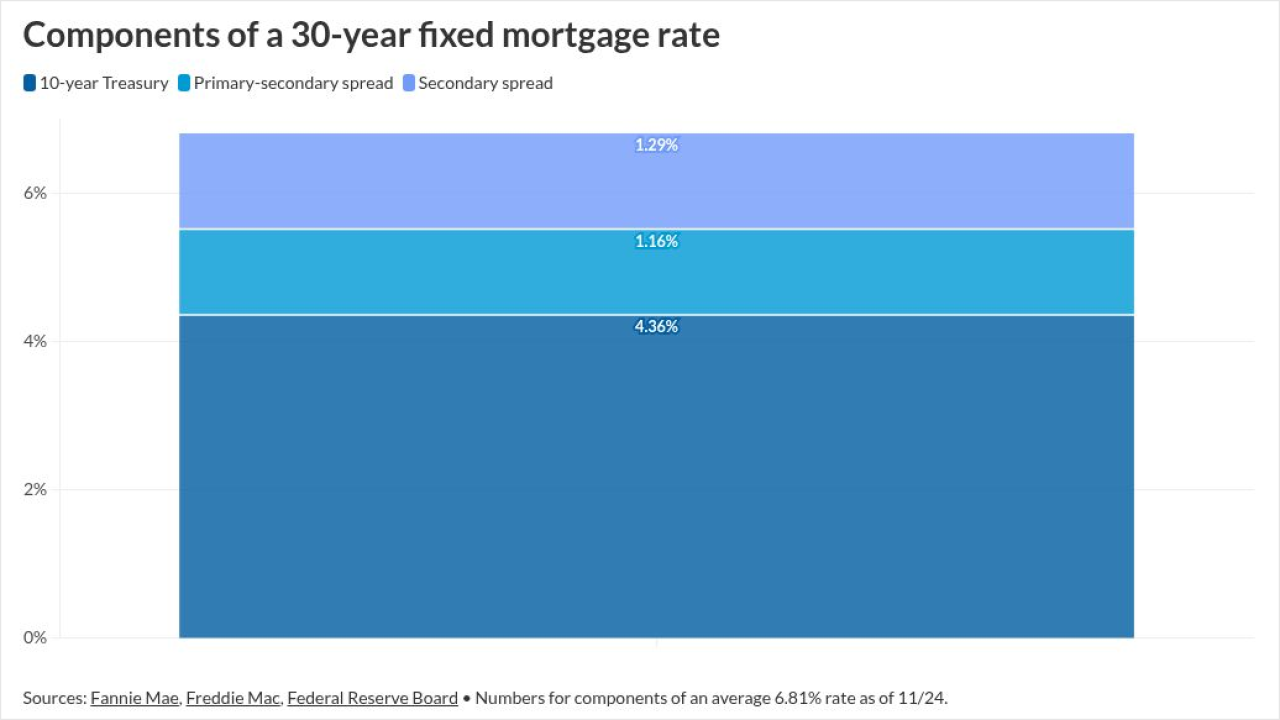BofA Securities estimates that the collateralized loan obligation (CLO) market's volume should reach $130 billion for 2022, a robust number that nevertheless puts CLO production on a downward swing.
Next year's origination volume may be considerably weaker, depending on macro factors and banks' reaction to them, both in terms of investing in CLO liabilities as well as originating leveraged loans, observers say.
This year's volume falls below 2021's $187 billion, which was a record, and the bank's original 2022 forecast of $135 billion. Slowing issuance over the last several months accounts for the new figures, said Pratik Gupta, head of RMBS/CLO at BofA Securities, adding that 2023 is likely to see volume drop more than 25%, to around $90 billion.
Issuance in 2021 was well above the previous record of $129 billion in 2018, according to Leveraged Commentary & Data.
The biggest reason for the drop, Gupta said, is CLOs' ongoing tight "arbitrage," as returns on the underlying loan assets have fallen, while liability payments to investors have increased. The arbitrage indicates the net income investors in CLO equity can expect at the time of issuance. As it lessens so does investors' motivation to invest in the riskiest part of the transaction.
Certain conditions could improve arbitrage, such as less costly CLO liabilities or higher leveraged-loan returns, or a combination of the two. However, the liability side faces challenges that may push spreads out further still, while a slowing economy could bolster returns on assets but also lead to bigger problems if prolonged.
One liability challenge is that the banks, which typically purchase upwards of 70% of 'AAA' and 'AA' tranches in CLOs, have reduced their participation in the market this year and may not bolster it until the latter half of 2023 or later, Gupta said. A second challenge, he said, is that a recession could hurt the loans that CLO managers buy.
"A lot more leveraged-loan borrowers would find it increasingly difficult to meet that higher interest rate expense when at the same time facing the economic specter of a recession," he said.
Expect a late-year surge
Nevertheless, the CLO market may see a jump in activity before year-end. Edwin Wilches, co-head of securitization products at PGIM, the asset management arm of Prudential Financial, said multiple dealers are aiming to complete deals — one has four in the wings — as demand increases. Overseas investors are under particular pressure to put capital to work.
"It couldn't surprise me if we get at least a dozen more deals this year," Wilches said.
The fallout of debt sell-offs
Another factor may be the widening spreads of CLOs, as investors have sold them alongside other fixed-income debt. The latter has been sold off in anticipation of deteriorating credit quality as interest rates rise. Meanwhile, investors have sold more liquid investments such as CLOs to raise cash as asset prices have fallen, according to a recent Janus Henderson report titled "The Fed and CLOs: Well aligned?"
The report notes the attractiveness of CLOs' floating rates given the likelihood of more rate hikes and the comparative safety of their investment-grade tranches.
"We believe this unsubstantiated selling has created a good opportunity to buy AAA CLOs at historically cheap valuations," the report says. "Further, we believe if relative spreads tighten from current levels, it could provide a tailwind for the asset class."
John Kerschner, head of securitized products at Janus Henderson, said that CLOs' 'AAA' tranches have typically returned about 2% more than cash investments such as T-bills — including a return of more than 6% today compared with approximately 4.5% for T-bills.
"And we think that's a better alternative for people who don't need [immediate] cash," Kerschner said.
In addition, he said, the AAA CLO bonds now trading around 97 to par may provide additional upside given their "pull to par," where the floating-rate securities, protected by layers of subordination, have typically traded. The riskier 'BBB' notes trade around 90 to par and provide even more pull. However, even if the economy moves sideways and prices don't improve, they should offer strong returns and are safer than alternatives.
"A lot has to go right for equities to return 10% next year, whereas with CLOs, even if their spreads don't tighten, the economy would likely have to materially worsen for BBB CLOs not to return 10%," Kerschner said.
Some market professionals, such as Daniel Ko, a principal and portfolio manager at Eagle Point Credit Management, believe that 'BBB' and 'BB' tranches provide very low impairment risk. Meanwhile, CLO equity is potentially more volatile, but it has performed well historically and potential returns today are well in excess of 20%, he said.
"Why does this opportunity persist? Because there's a general misunderstanding of CLO risk and the volatility we've seen in these securities," Ko said.
Bain Capital Credit opportunistically issued eight CLOs in the first seven months of this year and none since July, when liability spreads began widening significantly.
If the economy worsens, CLO liabilities are likely to remain wide and the arbitrage could remain unattractive, said John Wright, global head of credit investments at Bain Capital Credit. Those spreads have recently started to firm up, he added. If that continues and the economy avoids recession, then liabilities should tighten faster than the loan market, improving the arbitrage.
Widening liabilities can be attributed in part to the Federal Reserve imposing capital-requirement increases on 13 large banks in August. In its Nov.16 "CLO Alert" report, BofA Securities estimates the median capital requirement at banks increased by 80 basis points, causing them to shy away from more capital-intensive 'AAA' and 'AA' CLO notes, which they were the primary buyers of in 2021.
The report says banks may step back into the market in the first or second quarter of 2023, when they have built sufficient buffers to their capital ratios, although that scenario could change if loan growth remains healthy and deposits continue to decline.
"As we talk to bank investors, they don't have a lot of capital for going out and buying securitized 'AAA' product, and instead are investing in traditional lending," Wright said. Meanwhile, he said, Japanese investors face unfavorable foreign exchange rates and have also backed off top-rated CLO bonds.
It remains to be seen when investors might return to buying those products substantially, given immense secular pressures, such as the Ukraine war, unrelenting inflation and aggressive Fed rate hikes, according to Wilches.
The bigger problem: Assets
For now, the CLO market appears to be holding up well, because while production might have slowed, 2022 has been "an incredibly great year," Wilches said. He sees the arbitrage issue as less of an impediment, especially given the attractive debt tranche spreads whose pull-to-par provides additional yield, and other investors stepping in to buy top-rated CLO tranches in lieu of the banks.
"We have seen multiple registrations with the [Securities and Exchange Commission] for [exchange-traded funds] buying AAAs," Wilches said, adding U.S. pension funds have remained active in the space as well.
More problematic next year may be CLOs' assets. Wilches noted that the median Wall Street forecast is for the corporate default rate to increase to 3.5% from the current 1%.
"What I think will be very topical is the amount of 'CCC' loans in these portfolios," he said, adding that there are at least 30% of loans rated B-minus, one notch away from non-investment grade, and if downgrades pick up then "conviction from financial advisors will be tested."
Even so, such downgrades are far from imminent. Ko said at least a few more interest rate hikes would be required before corporate borrowers face difficulties meeting their loan interest payments. In addition, the predominance of covenant-light loans over the past several years should help borrowers withstand a year or more of higher rates before default risk increases. Take the Weight Watchers' bank debt from several years ago, Ko said. It was trading around 50 to par, but its lack of covenants and a sponsorship from Oprah Winfrey allowed it to recover. Eventually the loans paid off at par.
Yet should the U.S. enter a prolonged economic downturn, "cov-lite" loans may prove to be more problematic.
"Cov-light lowers the prospect of default, but it also lowers lenders' potential recoveries if borrowers do default," Ko said.





